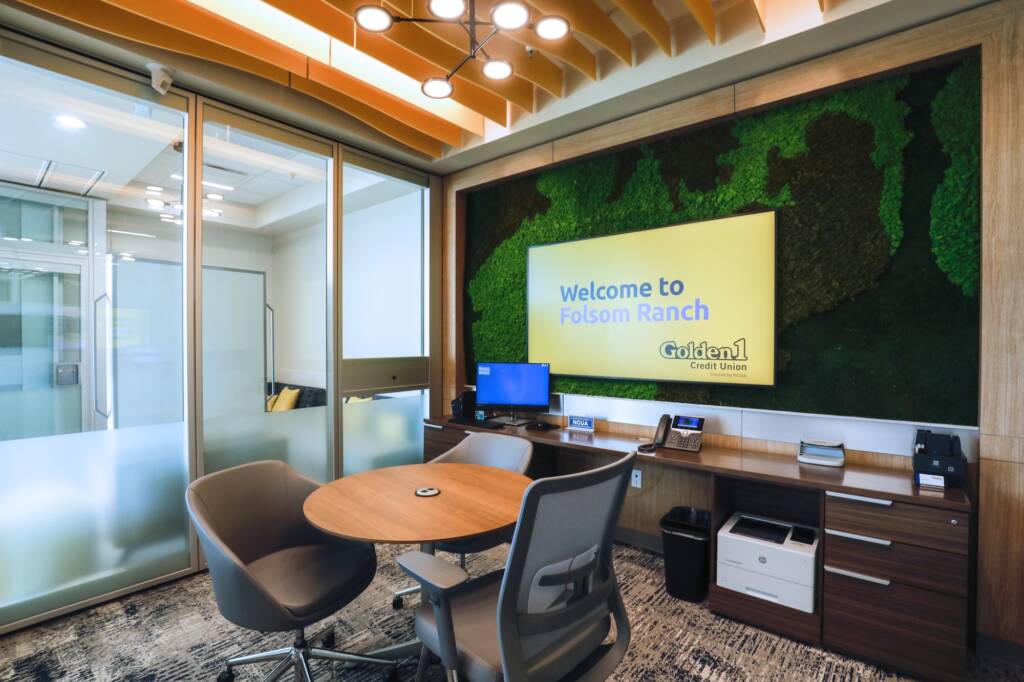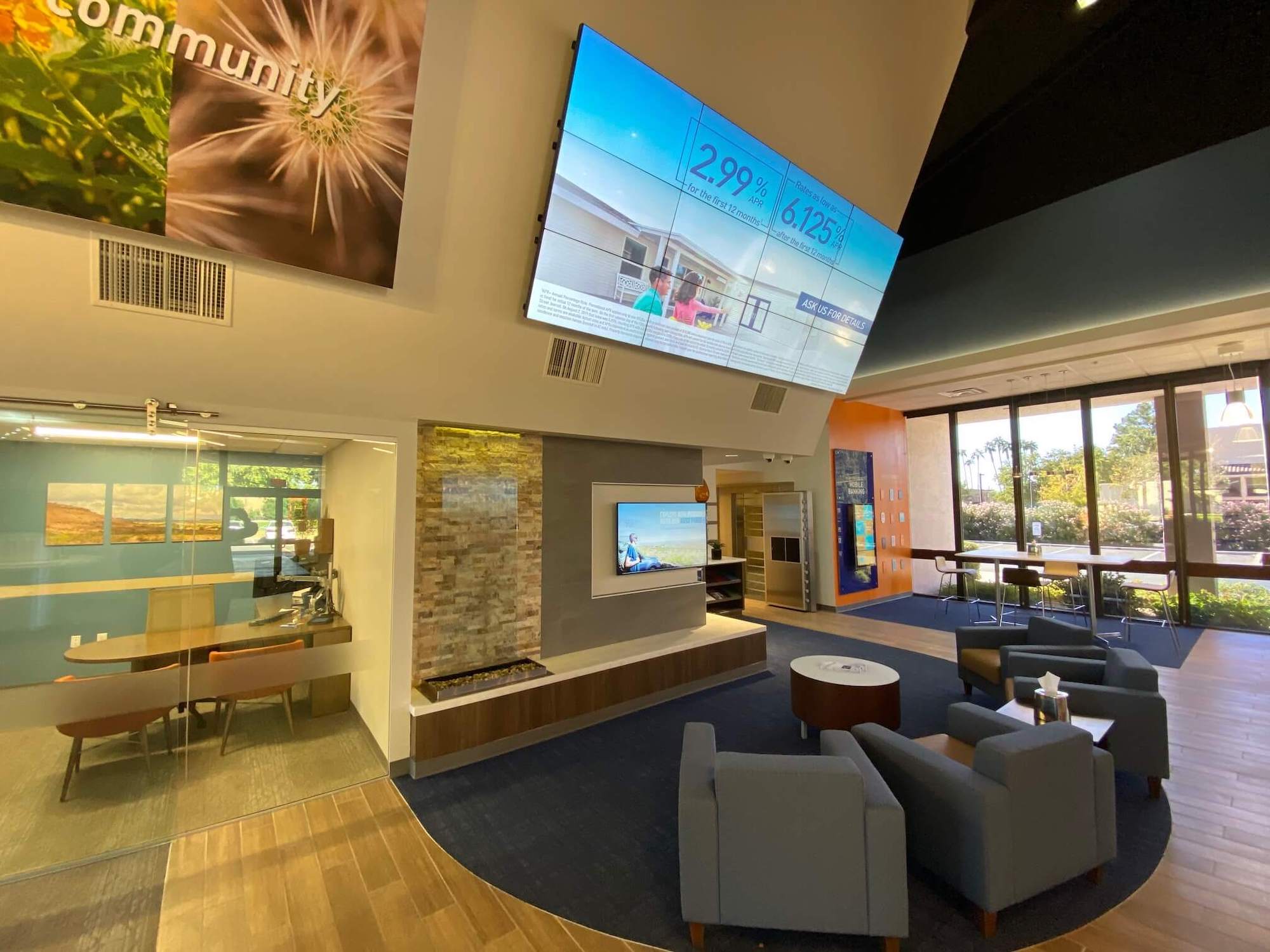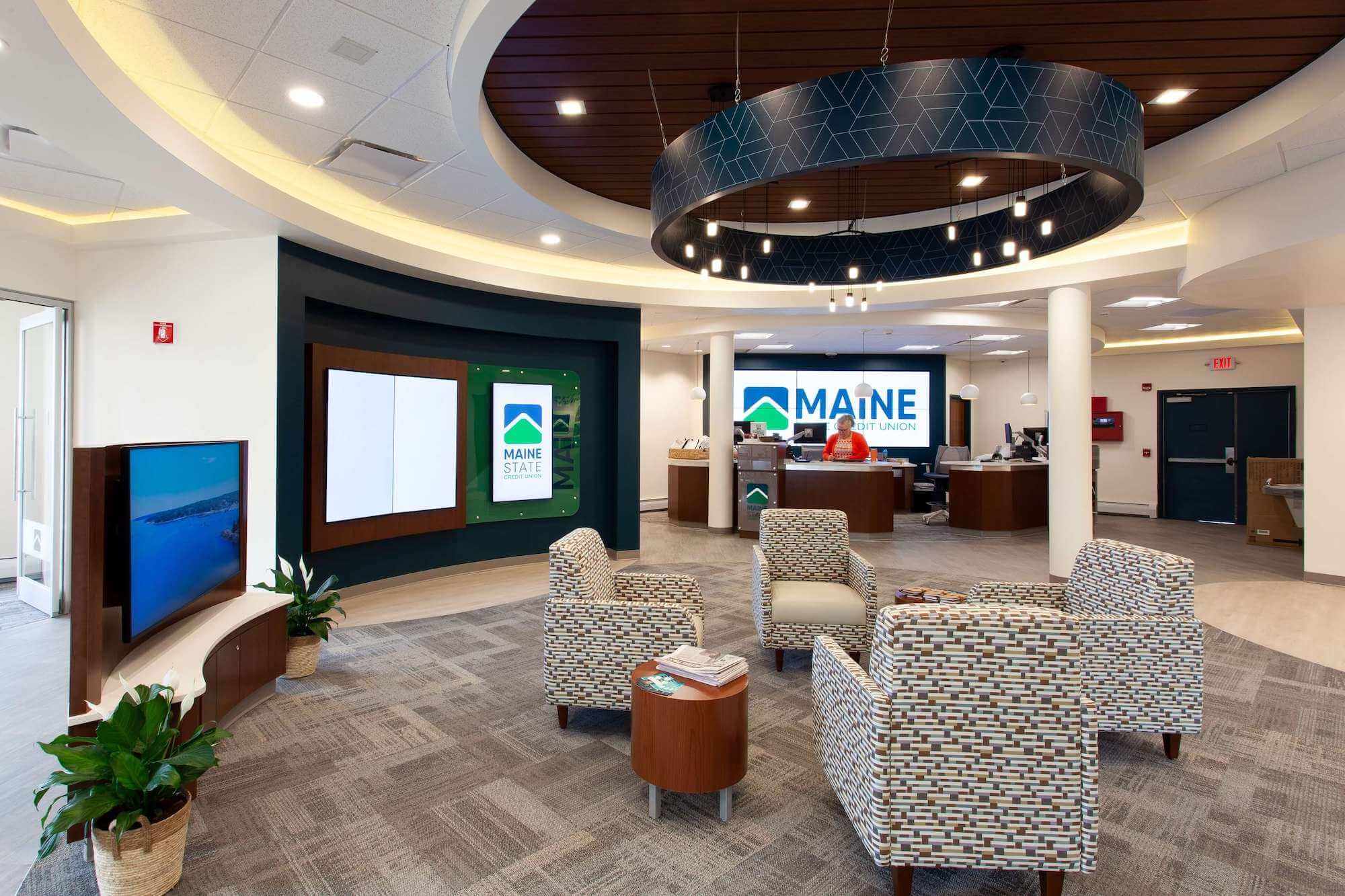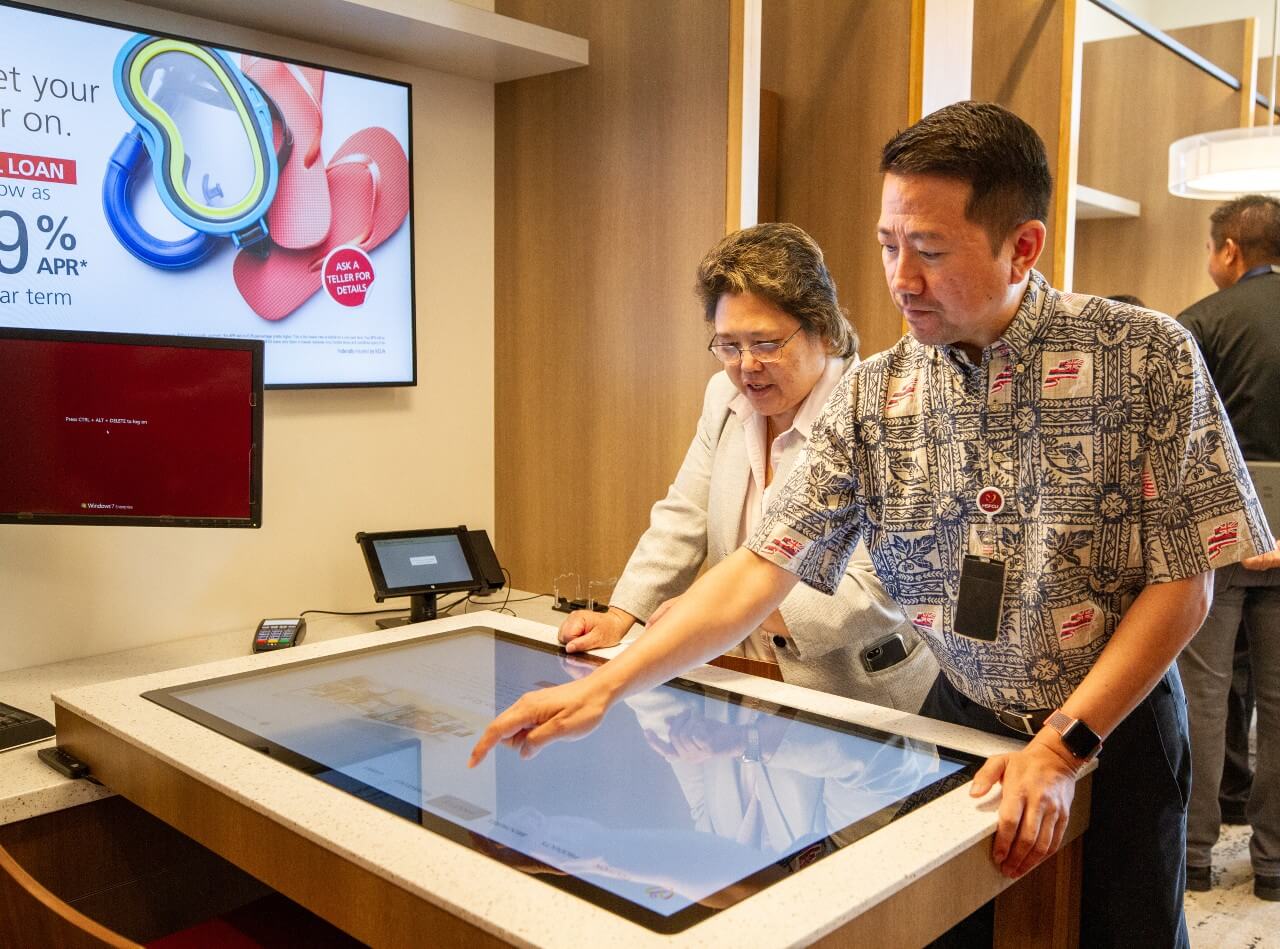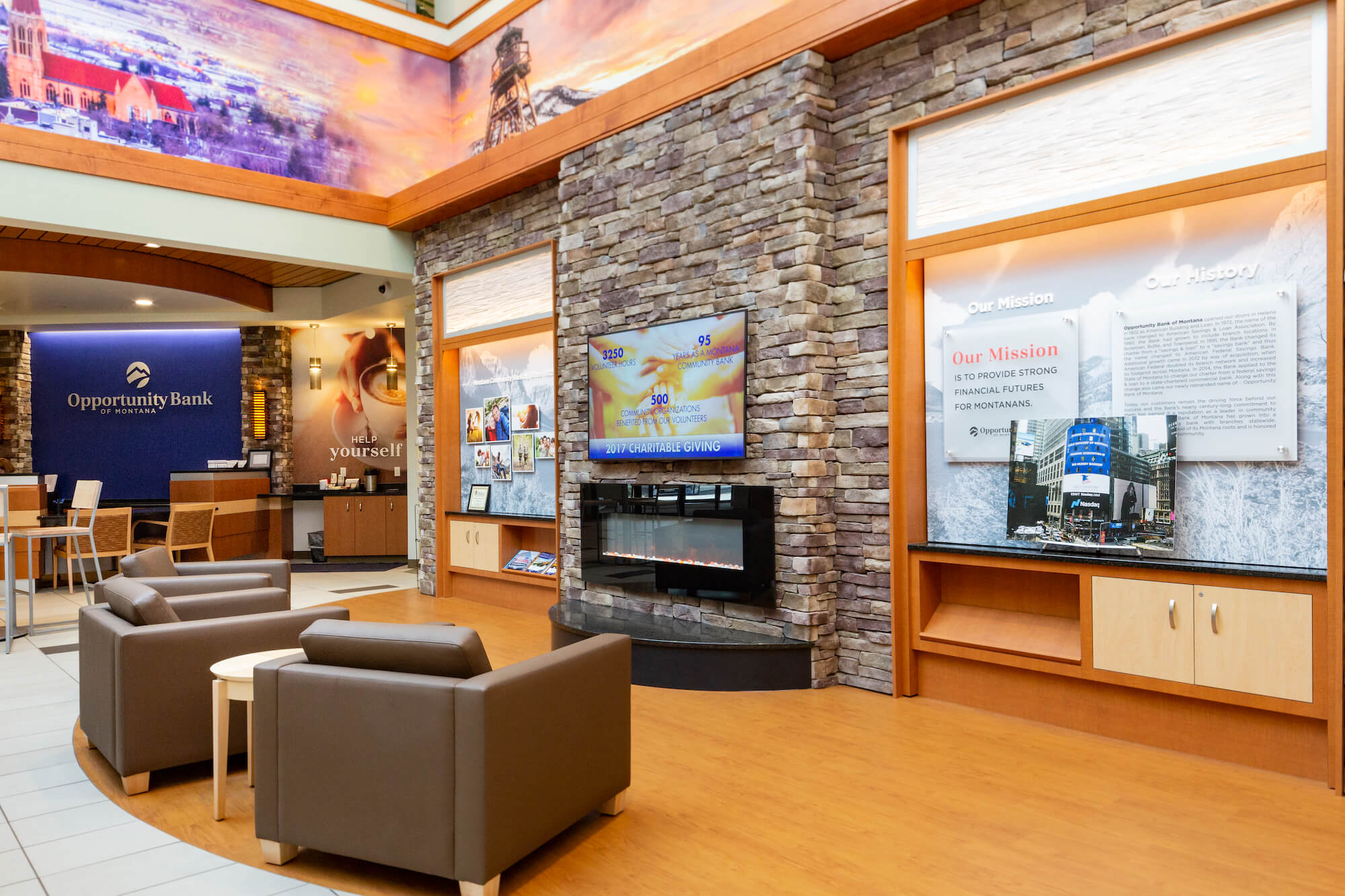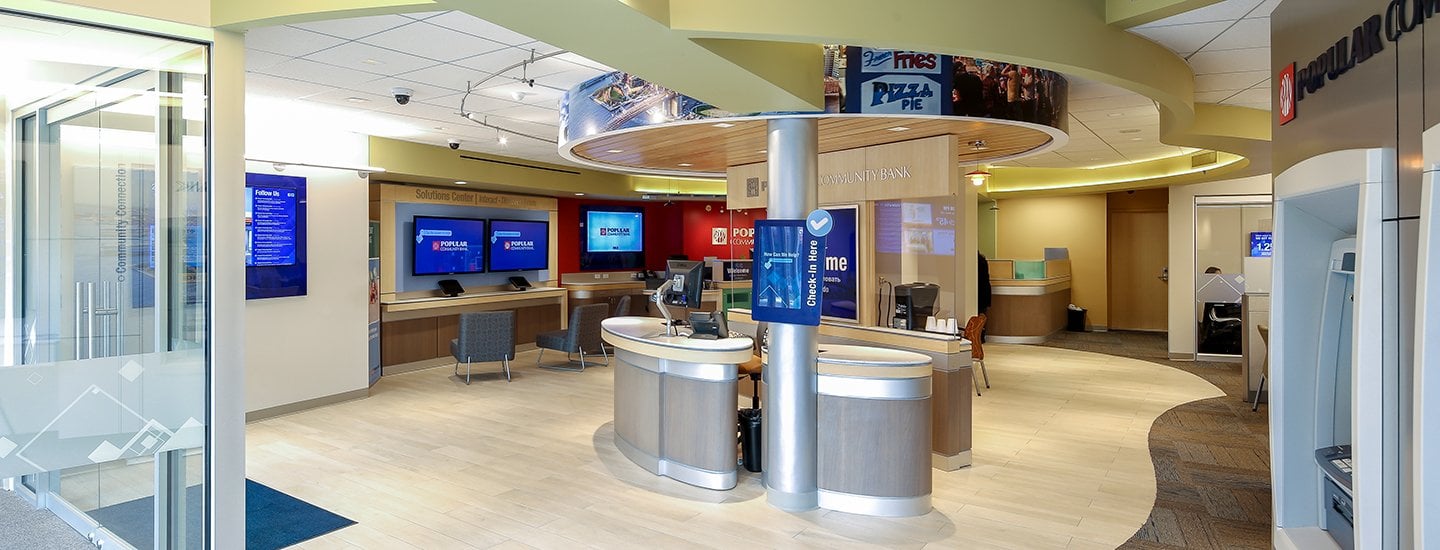Despite the growing popularity of mobile banking, the physical branch is still an intrinsic part of the consumer’s retail banking experience. Most people prefer to visit a branch to open accounts or perform complicated financial transactions. As a result, the in-branch experience is evolving into a more consultative — that is, less transactional — space.
Credit union and bank interior design trends are reflecting this shift with more open-concept floor plans, comfortable gathering spaces, and intuitive wayfinding design that maximizes promotional opportunities. Let’s take a look at some of the trends highlighting human connection in the retail banking space.
💡 Planning a new project? Schedule a design critique to see what’s possible before you commit. Our team will create and present a tailored concept that includes a floor plan, visuals, and recommendations.
The Value of the Physical Branch
No matter how easy your mobile app is to use, face-to-face interaction is still the best way to build relationships with your customers or members. In-person experiences enable branch agents to build authentic relationships with the public, which is a primary factor in maintaining customer loyalty.
Creating a physical space that maximizes these authentic interactions incentivizes customers and members to visit your branch when they need expert advice, whether they are opening a new account or signing their first mortgage loan. Thoughtful exterior and interior layout design can significantly enhance the customer experience, boosting brand perception and building loyalty.
So, what are some ways to achieve a modern bank branch design that enhances branch interactions? A key factor is visibility, which can be achieved through effective lighting, eye-catching digital signage, and strategic placement that wows prospective customers and members as they drive or walk by.
Additionally, sustainable design practices, including using locally sourced materials and incorporating green spaces, reflect your institution’s commitment to the environment and community. Other features — such as large windows for natural light, open and airy layouts, and strategic placement of entrances and walkways — can improve accessibility while also creating a welcoming atmosphere that draws customers in.
By thoughtfully designing both the interior and exterior, you ensure that the physical space serves its functional purpose and sets a tone of reliability and excellence, strengthening the connection between your brand and the community it serves.
By thoughtfully designing both the interior and exterior, you ensure that the physical space serves its functional purpose and sets a tone of reliability and excellence, strengthening the connection between your brand and the community it serves.
top trends in modern credit union & bank interior design
If fashion is anything to go by, trends come and go, but there are a few elements that continue to pop up in credit union and bank branch design. Yes, paint colors and upholstery are important considerations, but architects and interior designers are now thinking more dimensionally than that.
Unconventional signage
This trend covers wayfinding signage, promotional displays, message boards, responsive screens, and exterior or window-facing digital signage that extends your message past closing time. You can even think outside the screen and consider creative framing options — make your community calendar look like it’s playing on a vintage television or cut out circles in one wall to create dynamic info “bubbles.”
Experiential marketing
Consumers are looking everywhere for memorable experiences — why not provide some at your branch? Everything from promotional events to innovative environmental design to mascot contests can reinforce your brand while leading your customers and members to say, “Wow — that was different.”
Interactive elements
Provide your customers and members with responsive, interactive technology and other in-branch elements, and your brand almost literally comes to life. Video banking with remote tellers lends a human touch to transactions, and in-branch perks like coffee kiosks encourage visitors to stay in the space longer
These trends are more than gimmicks — the goal, especially for the traditional banking industry, is to inspire brick-and-mortar branch visitors to rethink the routine banking errand.
What follows is a deeper dive into each of these trends and how they shape the customer experience.
Addressing Customer Needs Through Design
“Sales” can sometimes get a bad rap these days — fewer people are interested in hearing sales pitches, especially when they can find all the information they need elsewhere.
Likewise, fewer customers are swayed by sales pitches alone. Other customers’ reviews or experiences (i.e., social proof) are a major influence on buying habits, as is the allure of the retail “experience.” As a result, creating the ultimate holistic customer experience has become a sales strategy in itself.
If a retailer offers an in-person experience that’s memorable enough, customers will make the effort to visit their brick-and-mortar locations. Therefore, retail banks and credit unions must tailor their physical spaces to prioritize ease, comfort, customer or member agency, and uniqueness.
Credit union and bank interior design elements that improve the customer experience include:
- Intuitive and attractive wayfinding signage that echoes the way someone might move naturally through a space.
- Multipanel video walls that immerse the viewer in your brand while informing, educating, and/or entertaining.
- Digital signage that turns your walls into a dynamic extension of your marketing strategy.
- Signature design elements that help create a consistent and unique aesthetic identity for your brand.
- Self-service tools — like kiosks, iPads, and ITMs — that hand customers and members the reins.
Incorporating these pieces into your space does not require massive square footage. In-store locations, satellite kiosks, and partial renovations can benefit from the right mix of well-placed (and functional) design elements.
The Importance of Multi-Functional Spaces
Open-concept floor plans aren’t just hot in home design. Bank and credit union design is evolving to prioritize spaces that are airy, comfortable, and fluid, complete with thoughtful touches intended to make visitors feel at home.
Community rooms: Most bank and credit union branches need conference rooms, both for internal and customer-facing meetings. But optimizing these spaces to meet even more needs will make your physical space that much more useful for customers and members. With a mix of formal and casual furnishings, you can turn a plain conference room into a comfortable waiting area, a flexible classroom, a children’s corner, an event space, and more.
Coffee bars: Coffee has been a staple of business for centuries; today, there’s hardly a hotel lobby or vehicle showroom without at least one steaming carafe or single-serve coffee maker. Some banks and credit unions are able to install fully staffed cafés into their branches, while others simply provide a well-stocked self-serve station. Either way, serving coffee on the premises communicates that you want your visitors happy, caffeinated, and ready to seize the day.
Coworking stations: A relatively new phenomenon, the coworking space has become a “third place” of sorts. Neither home nor formal workplace, the third place is somewhere in between, where people are free to meet, converse, relax, and work (together or alone). With the addition of cafés and community rooms, some banks and credit unions are embracing the coworking movement and providing a casual office-away-from-the-office with free WiFi and laptop charging stations — no financial transactions required.
Creating a community feel
While some banks and credit unions certainly stretch the definition of a multi-functional community space, customers and members respond well when financial institutions incorporate homey elements.
Plants: This seems like a simple addition, but living greenery can elevate a space from sterile to welcoming with minimal effort. There’s no shortage of low-maintenance plants out there that pack a visual punch and can even spark conversation from avid plant-loving visitors. Better yet, invite a local school or youth group to install a sustainable indoor garden as a community-building project.
Lighting: Anyone who’s ever worked for long periods under fluorescent lights knows that it’s not the most relaxing experience. A space that’s too dimly lit doesn’t set the mind at ease either. Natural light is the best way to brighten up your space; if you don’t have access to many windows or skylights, any warm, diffused light will have a more pleasant effect than buzzing fluorescent tubes.
Local touches: A financial institution that stands apart from its local community can feel impersonal and aloof. When your interiors feature local artists’ work, design elements that reflect the surrounding landscape, or digital content feeds that pull in local events calendars or business ads, visitors can feel that their bank or credit union is a true neighborhood staple.
Exterior design and physical layout: The exterior and layout of a building are vital in nurturing a sense of community. For example, leveraging local architectural styles and materials can enable bank and credit union branches to blend organically into their surroundings. Additionally, outdoor spaces such as patios, gardens, and small parks can offer spots for community events and gatherings. These elements help boost aesthetic appeal while strengthening connections between the branch and its community.
Smaller Locations Are Making a Comeback
Slower foot traffic in recent years has caused some financial institutions to close branches or reduce their footprint. But downsizing your space does not mean downsizing your reach; if anything, smaller branches allow you to reach even more people while keeping costs down. Smaller locations provide:
- More self-service banking opportunities
- Increased opportunity to reach new markets
- Extended business hours with 24/7 kiosks
- Expanded customer reach through virtual teller platforms
More banks and credit unions are cutting costs by downsizing while maintaining top-notch customer service. While this means fewer tellers at each branch location, those who remain can be cross-trained to provide more comprehensive financial services. These “universal tellers,” though smaller in number, deliver more value to both the financial institution and the customer.
The most skilled tellers can even serve customers and members in multiple branch locations without leaving their office. Virtual teller-enabled kiosks allow customers to access expert service from anywhere — even a 1,000-square-foot standalone satellite branch.
When designing smaller branches, it’s crucial to maximize every square foot. Open floor plans, multi-functional spaces, and efficient layout designs ensure that even compact branches can offer full services without feeling cramped. Incorporating elements like small seating areas or interactive kiosks can extend the branch’s usability and appeal, making the most of limited space.
Incorporating Digital Elements is Crucial
Nearly every bank or credit union has an app these days, but digital solutions should not be limited to remote banking. In-branch digital elements can include:
- Digital signage featuring product advertisements, tutorials, financial information, current interest rates, stock market data, social media feeds, event calendars, local weather, etc.
- Self-service tools, including 24/7 ATMs, ITMs, touch tables, and/or iPads
- Mobile tellers who bring tech tools directly to customers and members, reducing wait times and increasing convenience
Leveraging digital tools like these can help you optimize your customers’ time spent in-branch. Self-service options give customers freedom and agency, while digital signage can provide important information and reiterate your institution’s digital connectivity.
The integration of digital elements should complement the physical design of your branch and be visible from the outside, creating an inviting look and feel that attracts prospective customers and members even before they walk in. Strategically placed digital signage can guide customers through the space, while interactive kiosks can be positioned to maximize visibility, accessibility, and engagement. Combining these digital tools with a modern bank branch design enhances the overall customer experience, making your branch a hub of both technological and human interactions.
What Next?
We regularly find great design inspiration by looking outside the retail banking industry, keeping our eyes open for particularly innovative examples of excellent user experience design. For instance, Comcast’s Studio Xfinity stores use interactive displays and a welcoming layout to create an immersive customer experience. Similarly, the retail design of Apple Stores, with their open, transparent façades and inviting interiors, sets a high standard for customer engagement and accessibility.
Whether it’s the integration of modern bank branch design elements or enhancing the building’s exterior and layout, we are here to help. Have you seen any trends out there that catch your eye? Send us a note today, and let’s start brainstorming.
